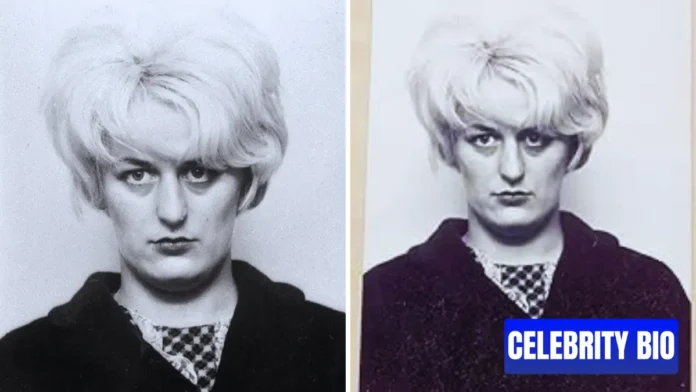Few names in British criminal history evoke as much horror and fascination as Myra Hindley. Often described as the “most hated woman in Britain,” Hindley’s involvement in the Moors Murders of the 1960s alongside her partner Ian Brady continues to cast a long, unsettling shadow over the nation. Her crimes not only shocked the public but also changed the way Britain viewed evil, innocence, and the capacity for cruelty.
This article delves deep into the real story of Myra Hindley — from her early life and relationship with Ian Brady to the psychological manipulation that led her into one of the darkest chapters in British history. It also explores the cultural impact and legacy of her actions, revealing why, decades after her death, she remains a subject of both fear and morbid curiosity.
Early Life and Troubled Beginnings
Myra Hindley was born on 23 July 1942 in Gorton, Manchester, into a working-class family struggling to make ends meet. Her father, Bob Hindley, was a World War II veteran who returned from the front deeply scarred, both physically and emotionally. The atmosphere at home was often tense, marked by aggression and volatility.
Despite her harsh upbringing, young Myra was considered bright and capable. She attended local schools and was known for her striking appearance — a trait that would later become part of her chilling public image. But beneath the surface, she was restless, searching for something more than the grey monotony of post-war Manchester.
The Fateful Meeting with Ian Brady
In 1961, at the age of 18, Myra Hindley took a job as a typist at Millwards Merchandising in Manchester. It was here that she met Ian Brady, a brooding, intelligent, and manipulative man with an obsession for Nazi ideology and sadistic literature. Their connection was immediate and intense — though deeply toxic.
Brady introduced Hindley to his dark fascinations, including the works of the Marquis de Sade and Adolf Hitler’s Mein Kampf. Gradually, he began to mould her worldview, convincing her that moral rules were meaningless and that ordinary emotions like guilt and empathy were weaknesses.
What began as a romantic relationship quickly spiralled into something more sinister. Under Brady’s influence, Hindley would transform from a shy young woman into an accomplice in a series of unspeakable crimes.
The Moors Murders: A Nation’s Nightmare
Between July 1963 and October 1965, Ian Brady and Myra Hindley abducted, sexually assaulted, and murdered five children and teenagers — Pauline Reade, John Kilbride, Keith Bennett, Lesley Ann Downey, and Edward Evans. The crimes became known as the Moors Murders because several victims were buried on Saddleworth Moor, near Manchester.
Hindley’s role in the crimes remains one of the most chilling aspects of the case. She drove the van, lured victims, and sometimes photographed or recorded their torment. The discovery of a tape recording of Lesley Ann Downey’s final moments, with Hindley’s voice in the background, horrified the entire country.
The pair’s final murder, that of Edward Evans in 1965, led to their downfall. Brady had invited Hindley’s brother-in-law, David Smith, to witness the killing. Smith later reported the crime to the police, leading to their arrest and the eventual discovery of the other victims.
The Trial and Public Outrage
In 1966, Myra Hindley and Ian Brady stood trial at Chester Assizes. Both were found guilty of multiple murders and sentenced to life imprisonment. The details revealed in court — photographs, recordings, and confessions — painted a picture of depravity that seemed almost beyond comprehension.
The British press labelled Hindley “the most evil woman in Britain,” a title she would never escape. While Brady was seen as the mastermind, Hindley’s participation as a woman made her crimes particularly shocking to a society that still viewed women as nurturing and maternal.
Her now-iconic mugshot, with platinum-blonde hair and an emotionless stare, became a symbol of female monstrosity in the public imagination.
Life Behind Bars
Myra Hindley spent the rest of her life in prison, serving time in several institutions including Holloway and later Highpoint Prison. In the early years, she remained loyal to Brady, even maintaining correspondence with him. However, by the 1980s, Hindley began to distance herself, claiming that she had been manipulated and controlled by him.
She converted to Catholicism, pursued education, and worked to present herself as rehabilitated. Several prominent figures, including prison officials and a few Catholic priests, argued that she had reformed. Yet public sentiment was unforgiving. Successive Home Secretaries, including David Waddington and Jack Straw, made it clear that Hindley would never be released.
Despite multiple appeals and campaigns from supporters, the British public’s hatred towards her ensured she would die behind bars.
The Psychological Debate: Victim or Villain?
Psychologists and criminologists have long debated Myra Hindley’s psychological state. Was she a willing participant in evil, or a victim of manipulation by Ian Brady?
Some experts argue that Hindley’s transformation was driven by her infatuation with Brady — that she sought his approval at any cost, losing her moral compass in the process. Others, however, point to her active participation in the crimes and her lack of genuine remorse as evidence of her complicity.
The truth likely lies somewhere in between. Hindley was both manipulated and manipulative — a complex figure whose humanity was eroded by a toxic relationship and unchecked moral decay.
Media Portrayal and Public Perception
The image of Myra Hindley has become one of the most powerful in British crime history. Her cold expression and bleached hair became the subject of countless newspaper covers and documentaries. To many, she personified evil itself.
Her story has inspired numerous films, books, and TV dramas, each attempting to understand — or exploit — her infamy. Yet, even decades later, any attempt to humanise her is met with fierce backlash.
In popular culture, Hindley’s name remains synonymous with betrayal, cruelty, and moral corruption. The public’s reaction reflects a deep-seated discomfort with the idea that evil can exist in such an ordinary form — a woman next door, capable of unimaginable acts.
Death and Controversy
Myra Hindley died on 15 November 2002 at West Suffolk Hospital, aged 60, after suffering from a respiratory infection brought on by heart disease. Her death sparked renewed public debate. Some expressed relief that “Britain’s most hated woman” was gone; others questioned whether she had truly repented in her final years.
Even in death, controversy followed her. Disputes arose over the disposal of her ashes and whether she deserved a Christian burial. For many, forgiveness was impossible — her name forever linked to the suffering of innocent children and the grief of their families.
Legacy of the Moors Murders
The Moors Murders changed the British justice system, media ethics, and public consciousness. It led to new conversations about parole, rehabilitation, and the limits of forgiveness. The victims’ families, particularly Winnie Johnson — mother of Keith Bennett, whose body was never found — became symbols of enduring grief and resilience.
Decades later, the crimes remain a cautionary tale about the depths of human cruelty and the dangers of manipulation. The moors themselves have become a haunting reminder of Britain’s darkest past — silent witnesses to atrocities that still echo in collective memory.
Lessons from the Myra Hindley Case
The story of Myra Hindley forces society to confront uncomfortable questions:
- Can evil be created through love and loyalty?
- Is redemption ever possible for those who commit unthinkable acts?
- And how should a society balance justice with mercy?
While the answers remain elusive, one thing is certain — the case continues to shape public and academic discourse about morality, gender, and criminal psychology. Hindley’s story stands as both a warning and a reflection of how ordinary people can become complicit in extraordinary evil.
Conclusion
More than sixty years after the Moors Murders, Myra Hindley remains one of the most infamous figures in British history. Her life and crimes continue to fascinate and repulse in equal measure, serving as a chilling reminder of how love, obsession, and manipulation can destroy lives.
Whether viewed as a monster, a victim, or a tragic product of her time, Hindley’s legacy endures — not because of who she was, but because of what she represents: the unsettling truth that evil often wears an ordinary face.
What are your thoughts on whether redemption is ever possible for someone like Myra Hindley? Share your views below — discussion helps keep history alive and remembered.
FAQs About Myra Hindley
Who was Myra Hindley?
Myra Hindley was a British murderer convicted in 1966 for her role in the Moors Murders alongside Ian Brady. She remains one of the most infamous criminals in UK history.
How many victims were there in the Moors Murders?
There were five known victims: Pauline Reade, John Kilbride, Keith Bennett, Lesley Ann Downey, and Edward Evans.
What was Myra Hindley’s sentence?
She was sentenced to life imprisonment with a recommendation that she should never be released.
Did Myra Hindley ever express remorse?
Hindley claimed remorse later in life, but many remain sceptical, viewing her statements as attempts to secure parole.
When and how did Myra Hindley die?
She died in 2002 from respiratory failure due to heart disease, aged 60, after spending over 35 years in prison.

